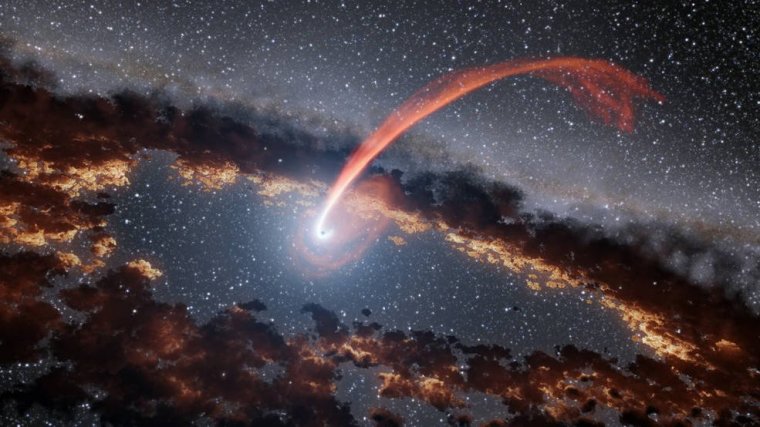| News / Science News |
Studies Find Echoes of Black Holes Eating Stars
NASA | SEPTEMBER 16, 2016
Supermassive black holes, with their immense gravitational pull, are notoriously good at clearing out their immediate surroundings by eating nearby objects. When a star passes within a certain distance of a black hole, the stellar material gets stretched and compressed -- or "spaghettified" -- as the black hole swallows it.

This illustration shows a glowing stream of material from a star as it is being devoured by a supermassive black hole in a tidal disruption flare. ![]()
A black hole destroying a star, an event astronomers call "stellar tidal disruption," releases an enormous amount of energy, brightening the surroundings in an event called a flare. In recent years, a few dozen such flares have been discovered, but they are not well understood.
Astronomers now have new insights into tidal disruption flares, thanks to data from NASA's Wide-field Infrared Survey Explorer (WISE). Two new studies characterize tidal disruption flares by studying how surrounding dust absorbs and re-emits their light, like echoes. This approach allowed scientists to measure the energy of flares from stellar tidal disruption events more precisely than ever before.
Flares from black holes eating stars contain high-energy radiation, including ultraviolet and X-ray light. Such flares destroy any dust that hangs out around a black hole. But at a certain distance from a black hole, dust can survive because the flare's radiation that reaches it is not as intense.
After the surviving dust is heated by a flare, it gives off infrared radiation. WISE measures this infrared emission from the dust near a black hole, which gives clues about tidal disruption flares and the nature of the dust itself.
Infrared wavelengths of light are longer than visible light and cannot be seen with the naked eye. The WISE spacecraft, which maps the entire sky every six months, allowed the variation in infrared emission from the dust to be measured.
Researchers found that the infrared emission from dust heated by a flare causes an infrared signal that can be detected for up to a year after the flare is at its most luminous. The results are consistent with the black hole having a patchy, spherical web of dust located a few trillion miles (half a light-year) from the black hole itself.
YOU MAY ALSO LIKE




